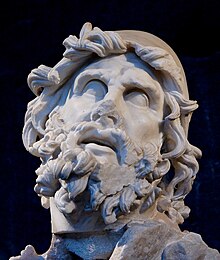Il ritorno d'Ulisse in Patria
| Il ritorno d'Ulisse in patria | |
|---|---|
| Opera by Claudio Monteverdi | |

Head of Odysseus (Ulisse), from the Sperlonga sculptures
|
|
| Librettist | Giacomo Badoaro |
| Language | Italian |
| Based on | Homer's Odyssey |
| Premiere | 1639–1640 Carnival season Teatro Santi Giovanni e Paolo, Venice |
Il ritorno d'Ulisse in patria (SV 325, The Return of Ulysses to his Homeland) is an opera consisting of a prologue and five acts (later revised to three), set by Claudio Monteverdi to a libretto by Giacomo Badoaro. The opera was first performed at the Teatro Santi Giovanni e Paolo in Venice during the 1639–1640 carnival season. The story, taken from the second half of Homer's Odyssey, tells how constancy and virtue are ultimately rewarded, treachery and deception overcome. After his long journey home from the Trojan Wars Ulisse, king of Ithaca, finally returns to his kingdom where he finds that a trio of villainous suitors are importuning his faithful queen, Penelope. With the assistance of the gods, his son Telemaco and a staunch friend Eumete, Ulisse vanquishes the suitors and recovers his kingdom.
Il ritorno is the first of three full-length works which Monteverdi wrote for the burgeoning Venetian opera industry during the last five years of his life. After its initial successful run in Venice the opera was performed in Bologna before returning to Venice for the 1640–41 season. Thereafter, except for a possible performance at the Imperial court in Vienna late in the 17th century, there were no further revivals until the 20th century. The music became known in modern times through the 19th-century discovery of an incomplete manuscript score which in many respects is inconsistent with the surviving versions of the libretto. After its publication in 1922 the score's authenticity was widely questioned, and performances of the opera remained rare during the next 30 years. By the 1950s the work was generally accepted as Monteverdi's, and after revivals in Vienna and Glyndebourne in the early 1970s it became increasingly popular. It has since been performed in opera houses all over the world, and has been recorded many times.
...
Wikipedia
